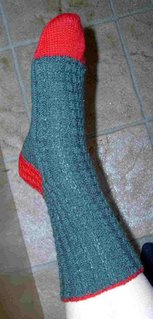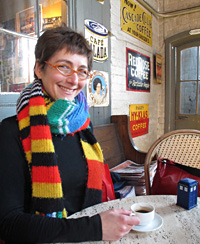
 Festive Sock (After Vogue Knitting's Holly Leaf Socks)
Festive Sock (After Vogue Knitting's Holly Leaf Socks)Ladies' one size fits all.
Materials:1 50gm ball green sock yarn (pick your favourite, I used Paton's Kroy 4 ply)
1 50gm ball red sock yarn (pick your favourite, I used Paton's Kroy 4 ply)
1 pair 2.5mm needles
Gauge:approximately 40 sts and 40 rows over 10cm/4 inch square in mock cable rib pattern
Method:Using red, and 2.5mm needles, cast on 64 stitches. Join, being careful not to twist the round.
First round: *Skip first stitch(leaving it in place on the needle) and k into second stitch, then k into first and slip both off the needle at the same time, p2; repeat from * to end of round.
Change to green and work leg in mock cable rib pattern as follows, until leg measures 6 inches/15 cm.
Mock Cable Rib (over a multiple of 4 stitches)
Rounds 1, 2 and 4: *K2, p2; repeat from * to end of round.
Round 3: *Skip first stitch(leaving it in place on the needle) and k into second stitch, then k into first and slip both off the needle at the same time, p2; repeat from * to end of round.
Set up for heel: work 34 stitches of next round in pattern (these are the instep stitches), attach red yarn, and work remaining 30 stitches of round in pattern. The 30 heel stitches should start and end with 2 knit stitches... if it's doesn't, fudge it by working 2 extra green stitches before you change to the red.
If it's easier to handle, slip the 34 instep stitches to a holder. Turn and work an additional 21 rows on heel stitches with red yarn, as follows:
WS: Slip 1, p1, *k2, p2; repeat from * to end of row.
RS: Slip 1, k1, work mock cable rib until last 2 stitches, k2.
You'll end with a WS row.
Foundation row for heel turn, RS facing: Knit 20, skp, turn.
Heel row 1, WS facing: Slip 1, p10, p2tog.
Heel row 2, RS facing: Slip 1, k10, skp.
Repeat the above two rows until all heel stitches have been worked. You'll end on a WS row, and there will be 12 stitches remaining. At this stage, you can cut the red yarn, leaving a tail to be woven in.
Go back to the green yarn tail position, at the end of the instep stitches. With the green yarn, pick up and knit 15 stitches along the left side of the heel, work the 12 heel stitches, and pick up and knit 15 stitches along the right side of the heel. Work across the instep stitches in pattern.
The start of the round is between the instep stitches and the left side of the heel. From here, you'll work the 34 stitches in the mock cable rib pattern, and the rest of the stitches will be in stotcking stitch.
Work one round even, twisting all picked-up sts.
Next round: K1, ssk, knit to last three stitches before instep stitches, k2tog, k1, work across instep stitches in mock cable rib pattern.
Work a round even.
Repeat these last two rounds until you're back to 64 stitches.
Work until foot measures required length -- 2 inches/5 cm shorter than total foot length. Your stitches will be arranged as follows: needle 1 has 15, needle 2 has 15, needle 3 has 34.
You'll finish the toe in plain stocking stitch.
Decrease for toe:
Needle 1: K1, ssk, knit to end. Needle 2: Knit to last three stitches, k2tog, k1. Needle 3: k1, ssk, knit to last three stitches, k2tog, k1.
Knit three rounds even.
Work a decrease round followed by two even rounds, twice. (6 rounds total)
Work a decrease round followed by one even round, three times. (6 rounds total)
Work decrease rounds until 8 stitches remain.
Cut yarn and thread through remaining stitches to close. To finish, weave in ends.
 This is the 2007 "Knitting Pattern a Day" calendar. And I'm in it! Twice!
This is the 2007 "Knitting Pattern a Day" calendar. And I'm in it! Twice! Mum's working on this...
Mum's working on this...
 And then you knit tubes for the sleeves in k2p2, so I figure I'll cut out a repeat, since I have little arms anyway... and then the edging all around is k2p2 again, so I'll just eyeball it. Easy peasy!
And then you knit tubes for the sleeves in k2p2, so I figure I'll cut out a repeat, since I have little arms anyway... and then the edging all around is k2p2 again, so I'll just eyeball it. Easy peasy!

 Festive Sock (After Vogue Knitting's Holly Leaf Socks)
Festive Sock (After Vogue Knitting's Holly Leaf Socks)
 Done!
Done!